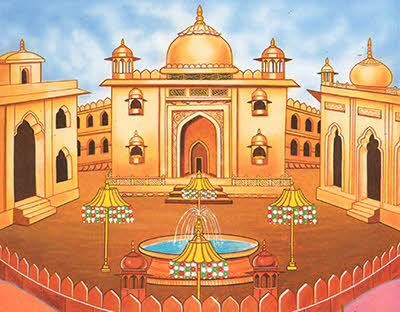
Taking their families and all their retinue and ascending the best of cars, they went to Vaitadhya. They landed on Mt. Vaitadhya which is kissed by the mass of waves of the Lavana Ocean at its borders, placed like a measuring-rod between the east and west quarters; a boundary between the northern and southern parts of Bharata, fifty yojanas wide north and south; buried six and a quarter yojanas in the earth, twenty-five yojanas high; embraced on all sides by the Gangas and Sindhu rivers as if by Mt. Hima with arms stretched out from afar; possessing caves named Khandaprapata and Tamisra that were like houses of pleasure and rest of the Sris of the two halves of Bharata; endowed with wonderful splendor from its peak Siddhayatana having the eternal images, like Sumeru with its crest; possessing nine peaks made of various jewels, lofty pleasuregrounds of the gods, resembling the nine Graiveyaka-heavens; supporting two rows of dwellings of the Vyantaras on the north and south sides, like garments, twenty yojanas above the ground; made of beautiful silver slabs from base to peak, like an anklet that had fallen from heaven to earth; calling them frequently from afar, as it were, by its arms of large tree-tops shaken by the wind.
Ten yojanas above the earth, King Nami made fifty cities on the mountain in a southern row. Prakkinnara, Naragita, Bahuketupura, Pundarika, Haritketu, Setuketupura, Sarpariketunagara, Sribahu, Srigrha, Lohargala, Arijaya, Svargalilapura, Vajrargala, Vajravimokanagara, Mahisara, Puranjaya, Sukrtamukhi, Caturmukhi, Bahumukha, Rata, Virata, Akhandalapura, Vilasayonipattana, Aparajita, Kancidama, Suvinaya, Ksemankara, Sahacihnapura, Kusumapuri, Sanjayanti, Sakrapura, Jayanti, Vaijayanti, Vijaya, Ksemankari, Candrabhasapura, Ravibhasapura, Saptabhutalavasa, Suvicitra, Mahaghna, Citrakuta, Trikutaka, Vaisravanakuta, Sasipura, Ravipura, Vimukhi, Vahini, Sumukhi, Nityodyotini, and Nami himself lived in Srirathanupuracakravala, the capital city among these cities.
In the same way Vinami made at once sixty cities in a northern row at the command of the Naga-king. Puryarjuni, Varuni, Vairisamharini, Kailasavaruni, Vidyuddipta, Kilikila, Carucudamani, Candrabhabhusana, Vansavat, Kusumacula, Hansagarbha, Meghaka, Sankara, Laksmiharmya, Camara, Vimala, Asumatkrta, Sivamandira, Vasumati, Sarvasiddhastuta, Sarvasatrunjaya, Ketumalankanagara, Indrakanta, Mahanandanas, Asoka, Vitasoka, Visokaka, Sukhaloka, Alakatilaka, Nabhastilaka, Madira, Kumudakunda, Gaganavallabha, Yuvatitilaka, Avanitilaka, Sagandharva, Muktahara, Animisavistapa, Agnijvala, Gurujvala, Sriniketapura, Jayasrinivasa, Ratnakulisapattana, Vasisthasraya, Dravinajaya, Sabhadraka, Bhadrasadyapura, Phenasikhara, Goksiravarasikhara, Varyaksobhasikhara, Girisikharaka, Dharanivarani, Sudarsanapura, Durga, Durdhara, Mahendra, Vijaya, Sugandhini, Suratanagarapura, and Ratnapura. Vinami himself, who had resorted to Dharanendra, inhabited the city Gaganavallabha, the capital of these.
The two rows of Vidyadhara-cities looked very magnificent, as if the Vyantara rows above were reflected below. After making many villages and suburbs, they established communities according to the suitability of place. The communities there were called by the same name as the community from which the men had been brought and put there. Then Nami and Vinami established the Lord, the son of Nabhi, in these cities in the assembly as in their own minds. “Do not let the Vidyadharas, insolent because of their vidyas, show disrespect.” Dharanendra instructed them about the law as follows: “If any insolent persons show disrespect or do injury to the Jinas, or the Jinas’ shrines, or to those who will attain moksa in this birth or to any ascetics engaged in pratima, the vidyas will abandon them at once, just as wealth abandons lazy people. Whoever kills a man with his wife, or enjoys women against their will the vidyas will abandon him at once.” After proclaiming aloud this law to last so long as the moon, the Master of the Nagas had it inscribed in edicts on the jeweled walls. After installing them by his favor in the lordship of the Vidyadharas and after laying down the law, the Indra Dharana departed.
There were sixteen classes named after their respective vidyas: Gaureyas from the name of the Gauris; Manupurvakas from Manus; Gandharas from Gandharas; Manavas from Manavis; Kausikipurvakas are known from the vidyas Kausikis; Bhumitundakas are named from the vidyas Bhumitundas; Mulaviryakas are known from the vidyas Mulaviryas; Sankukas from the Sankukas; and Pandukas from the Pandukis; Kalikeyas from the Kalis; Svapakakas from Svapakis; Matangas from Matangis; Parvatas from the Parvatis; Vansalayas named from the Vansalayas; Pansumulakas known from the Pansumulavidyas; and Vrksamulakas from the vidyas Vrksamulas.
After dividing them, King Nami took eight classes of the Vidyadharas and Vinami took eight. With devotion they established divinities presiding over the vidyas in each class just as in their own hearts. They constantly observed the suitable occasions for puja to Rsabhaswamin’s image and, without any injury to Dharma, enjoyed delights like gods. Sometimes they, like another Sakra and Isana, sported with beautiful women in the lattice window-recesses on the wall around the continent. Sometimes in the gardens, Nandana, etc., on Sumeru’s peak they wandered, always joyful, free as air. Sometimes they went to the holy places of Nandisvara, etc., for worship of the eternal images. That is the fruit of a layman’s prosperity. Sometimes in the zones Videha, etc., they went to the samavasarana of the holy Arhats and drank the nectar of their speech. Sometimes they listened to the preaching of Dharma by flying ascetics, their ears pricked up like young deer listening to a song. Possessing right belief, their treasuries undiminished, surrounded by Vidyadharas, they exercised sovereignty fittingly without injury to the three things (Dharma, wealth, love).











No comments yet.
Leave a comment